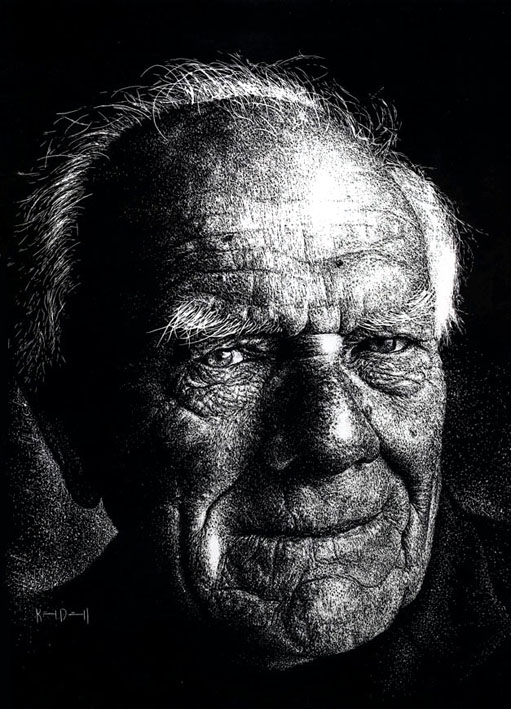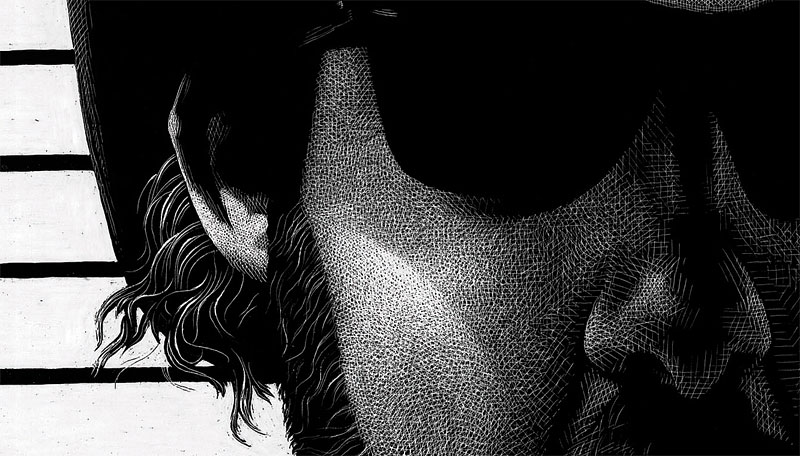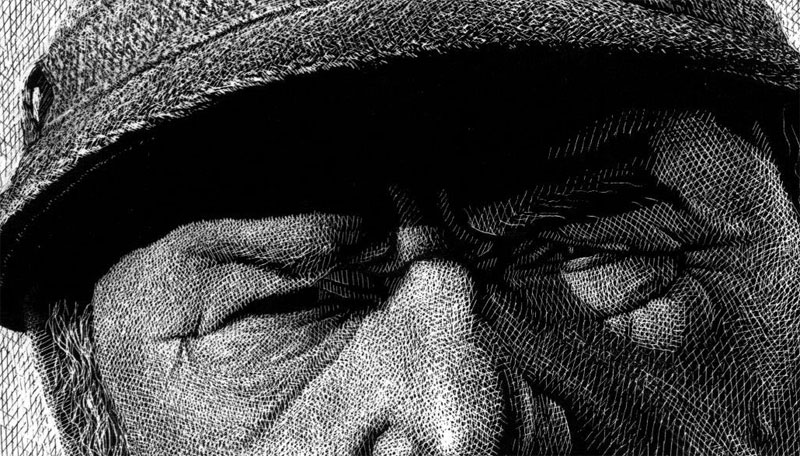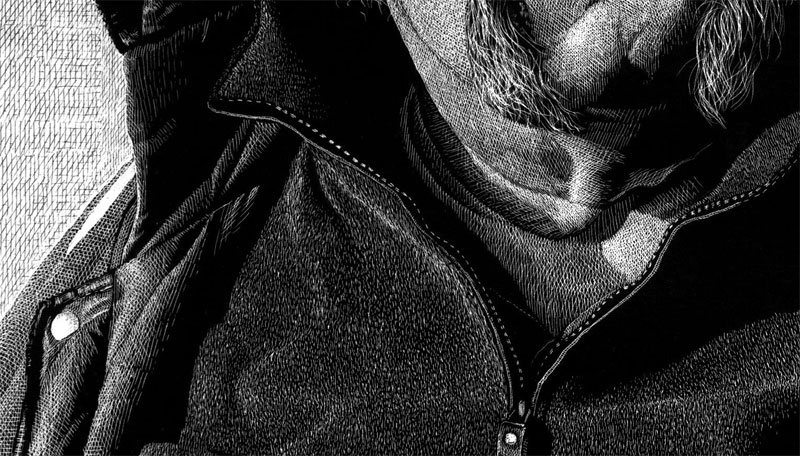This is a nice portrait by Kim Dingwall. I really like the rustic textures on the face. The treatment of the hair reminds me of some advice I received long ago: “Plan to spend as much time on the hair as you do on the face”. In this case there isn’t as much hair to worry about as there might be, but it’s still important. The little wisps of hair coming out of the bald areas add to the realism. The contrast of his white eyebrows against the shadow side of his face adds to it as well. They are very deliberate and believable. Working in scratchboard can be a balance between what to show and what to leave in the dark…even if it’s in the reference photo. The light stippling around the shoulders is an example of that. The shapes of the ear and shoulders are revealed in a subtle way that adds dimension but doesn’t overpower.
Category Archives: people
Steve Carroll – scraperboard portrait tips and closeups – Nice!
I asked Steve Carroll if he would let me show some of his images on the site, and if he wouldn’t mind giving some additional information about his process. He far exceeded my expectations. The images are beautiful and large enough to see the hatching patterns he uses. I had been interested in seeing them up close, and today I got my chance. I am also grateful to learn more about his techniques. Thanks, Steve, for being so willing to share.
Steve also has a Facebook page
Here is Steve explaining the process in his own words:
First of all, I draw a preparatory sketch of my subject on to thin ‘layout’ out paper which 80 grams per square metre (English spelling!). Once I am satisfied with the drawing, I turn over the paper and cover this side with white conte crayon or chalk. Then I tape down the paper on to the scraperboard drawing side up and using a hard pencil (4H) I draw over the original sketch design with moderate pressure. Once all the main reference lines are transferred on to the board I lift off the paper and with a soft brush take away any loose chalk dust.
Now I have my white lines as a guide, I can start scratching/scraping to my hearts content. I keep minimal contact with my fingers, so I place a sheet of paper under my drawing hand – this prevents smudging the white guide lines. When I am happy that no more scratching is needed I use a slightly damp cloth or paper towel to wipe away the chalk lines and there you will have a smart looking image to be proud of!
I use ‘Essdee’ British Scraperboard. And to cut the black ink away I use ‘scraper cutters’ as seen in the photo. I use the index pen nib to correct the ‘rare’ mistake! by adding Indian ink back on to the surface. (don’t tell anyone this!) As well as these tools, I also have a smooth oil stone to sharpen the cutters as inevitably the blades can become blunt which affects the quality and consistency of the line.
The textures are created by using the crosshatching method and also using a stippling effect.
The latter technique is far more time consuming but rewarding if used in the correct context (see Andrew Townsley’s fleece jacket). On the odd occasion I scrape large areas off altogether and draw and/or dab ink back onto the board, and scrape this again creating a rich and complex texture.These are just some of many approaches you can try. This medium is only limited by your imagination. So what are you waiting for – get down to your local art store and buy the relevant materials and scrape/scratch away. Don’t worry about making mistakes, remember the index pen nib! And besides, making mistakes is good for you, it’s the best way to learning and improving your techniques.
chottoMatte – black is the colour
The description on DeviantArt says: “scratchboard self portrait. Old one, for illustration class at university”. It’s a very strong image. All the shapes are interesting, and the high-contrast rendering really makes it pop. I like how the rough border contrasts with the smooth contours of the hair and shoulders. 
Kent Barton – Indiana Jones
Kent Barton’s scratchboard illustration work is some of the best around. This piece isn’t new, but it sure is beautiful. My wife said, “The longer you look it, the cooler it gets”. I completely agree. The heavy lines create the mid-tone that ties everything together, while the overlayed ink hatching creates the darker shadows. I like how short scratches give character to the highlights, and the detail is completely blown out in the lit side of the face. The stippling on the hat is a nice contrast to the surrounding linear strokes. It really is a masterpiece. Even the abstract background has its own visual journey to enjoy.

Bob Boze Bell – Rattlesnake Kate
I’ve come across True West Magazine a number of times, admiring the sketches and quick paintings. Bob Boze Bell is the one running the show, and on 11/11/11 he wrote:
“In honor of this uno-alignment I switched gears on my “Not So Gentle Tamer” concept and did a black and white (actually scratchboard) of an Arizona Pioneer Woman dispatching a Mohave Ring-tailed Rattlesnake with a shovel.”
The finish on this is very rough, but I think it’s a gem.
Ricardo Martinez – killer drawing and masterful texture
Gifted beyond belief, Ricardo Martinez does the kind of work that makes me feel like a total art weakling. His ideas are great. His designs are great. He captures light and shadow with variety of crosshatching patterns, which give his work rich texture and style. If a gallery had all of his work hanging, I think I would take a very good look at each piece…multiple times. All at the same time it inspires and depresses me.
The gorilla is awesome, but the scratches that make up the leafy background are even more amazing – my favorite part of the image.

The skin of the whale blows me away. It has texture and yet looks smooth. The light and shadow really make this piece work.

A new board by Russ McMullin – George Washington
No long ago I saw a painting by Gilbert Stuart from 1795 that inspired me to try a portrait of George Washington. I’ve thought about this before, but never got around to it. With Stuart’s portrait as a jumping off point I ended up with something I was pretty pleased with.
This is done on 8×10 Ampersand Scratchboard, using a #16 Xacto blade. Sakura and Staedtler pigment pens were used to touch up my mistakes.











